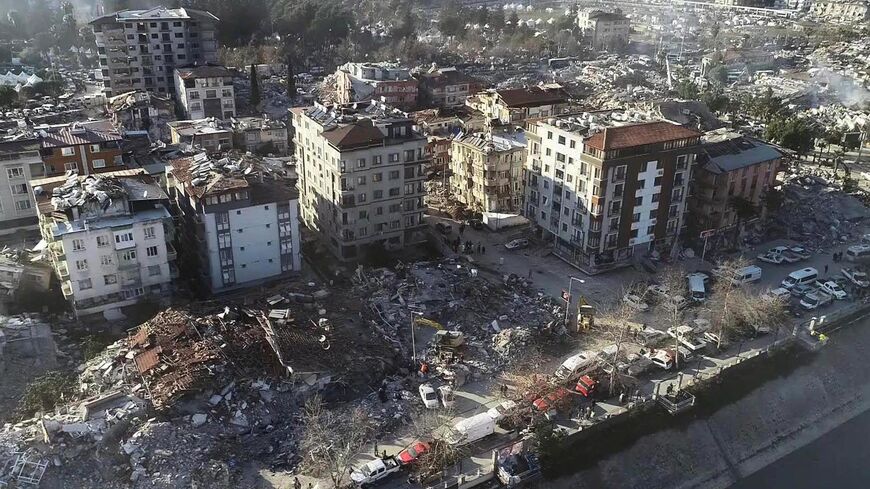With its economy already fragile, Turkey now braces for a widening budget deficit, fresh inflationary pressures and a blow to its gross domestic product (GDP) after a pair of massive earthquakes devastated vast areas in the country’s southeast.
The disaster struck in the lead-up to the May 14 elections, turning up the pressure on President Recep Tayyip Erdogan, who faces the toughest yet re-election race in his two-decade rule. With annual inflation running at nearly 58%, Erdogan had hoped to deliver some economic relief to an electorate exasperated by skyrocketing prices before the crucial polls.
The disaster response now requires a significant increase in public spending to meet the needs of 13.5 million affected people — 15.7% of Turkey’s population — and rebuild massive destruction across 10 provinces. As a result, the government’s budget deficit, projected at 3.5% of the GDP in 2023, is likely to grow to up to 5% of the GDP, threatening to exacerbate Turkey’s current account deficit and other economic fragilities.
Touring quake-hit areas since Wednesday, Erdogan announced financial aid of 10,000 Turkish liras ($531) for each affected family and pledged that the government will build new homes for the victims within a year and pay the rents of those unwilling to stay in tents.
The two quakes, which hit nine hours apart on Monday, destroyed about 7,000 buildings, most of them residential blocks. The death toll surpassed 19,000 on Friday afternoon, and it is expected to rise faster once rubble clearing begins after rescuers wrap up their search for survivors in piles of tangled metal and concrete. The accommodation of quake victims is looming as a major task in the short run, with about 76,000 people already evacuated to other regions amid harsh wintry conditions.
The 10 affected provinces account for about 9% of Turkey’s GDP. The most industrialized among them is Gaziantep, at the Syrian border, which contributed 0.25 percentage points to Turkey’s 11.4% growth rate in 2021, ranking eighth among 81 provinces.
Turkey’s economic growth in 2022 is expected to be in the range of 6% to 7%, with the official data scheduled for release on Feb. 28. The government’s projection for 2023 stands at 5%, but many pundits were already estimating that the economy would expand about 3% at best due to existing fragilities and belt-tightening measures expected after the elections. That rate is now likely to drop a bit further due to the economic fallout of the quakes.
According to a rough estimate, the cost of destroyed apartments alone is $6.3 billion, assuming that the collapsed buildings housed about 6,000 apartments with an average worth of 2 million liras ($105,000) each. Factoring in damaged buildings that have become unusable, the figure would reach $10 billion. A separate multibillion-dollar bill will emerge from damage to public facilities and infrastructure, including roads, bridges and airports, as well as industrial facilities, farms and other businesses.
The economic contraction looming in the 10 affected provinces is expected to bear on Turkey’s overall GDP this year. In 2022, the country’s GDP is estimated to have reached $862 billion and GDP per capita $9,893.
In its medium-term economic program, the government projects a GDP of $867 billion in 2023, meaning a GDP per capita at $10,071 — a target that is now unlikely to be achieved considering also the prospect of the lira weakening further. The average GDP per capita in the quake-hit provinces, which was already just two-thirds of the national average, is likely to drop further to somewhere between $5,000 and $6,000. That said, a rehabilitation drive to rebuild homes, business premises and infrastructure, possibly with foreign financial support, might curb economic contraction in the region to some extent.
The disaster threatens to hit the agricultural output of the affected region, which accounts for some 15% of the country’s total. A decline in agricultural supplies, in turn, could fuel Turkey’s food inflation, which stood at 71% in January.
Turkey’s foreign trade volume is also likely to suffer, given the disruptions in industrial activity, transport and logistics expected across the quake-ravaged region, along with the loss of manpower. In 2022, exports from the 10 provinces were worth $21.5 billion, representing 8.5% of all Turkish exports, according to official data. Gaziantep accounted for half of those exports, followed by the province of Hatay — home to a seaport serving as a link to Middle Eastern countries — with $4.1 billion worth of exports and Adana with $3.1 billion.
A decline in exports from the region, even if temporary, would add to Turkey’s current account troubles. The country’s current account deficit is estimated to have reached some $45 billion last year.
The disruptions in industrial and commercial activity would also mean less tax revenue flowing into the Treasury’s coffers. The government has already deferred all tax liabilities in the region until the end of July. The 10 affected provinces contributed 7.5% of Turkey’s tax revenues of 2.3 trillion lira ($122.1 billion) last year, official data show.
Similarly, setbacks in loan repayments in the region might leave banks under strain.







